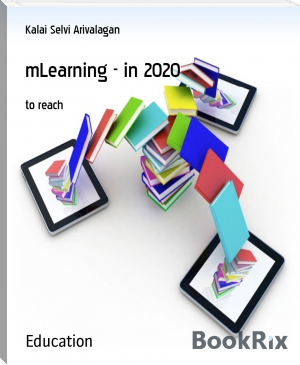INNOVATIONS IN SCIENCE, TECHNOLOGY AND MATHEMATICS EDUCATION IN NIGERIA by Ebele C. Okigbo, Nneka R. Nnorom, Ernest O. Onwukwe (the ebook reader .txt) 📖

- Author: Ebele C. Okigbo, Nneka R. Nnorom, Ernest O. Onwukwe
Book online «INNOVATIONS IN SCIENCE, TECHNOLOGY AND MATHEMATICS EDUCATION IN NIGERIA by Ebele C. Okigbo, Nneka R. Nnorom, Ernest O. Onwukwe (the ebook reader .txt) 📖». Author Ebele C. Okigbo, Nneka R. Nnorom, Ernest O. Onwukwe
Game-Based learning Strategy as a measure of improving Senior Secondary School students’ academic achievement in Geometry in anambra state
Prof. Ebele C.Okigbo
&
Benson C. Ezeanyi
Abstract
This study investigated the effect of game-based learning strategy on academic achievement of senior secondary one (SS1) students in geometry in Awka South Local Government Area of Anambra State. A pre-test, post-test, control group quasi experimental design was adopted for the study. Two research questions and two hypotheses guided the study. The population of the study was 17, 203 SS1 students and a sample of 100 students were selected using multi stage sampling. Geometry Achievement Test (GAT) was the instrument used for the collection of data for the study. The instrument was validated by three experts and reliability coefficient established using mean, standard deviation and analysis of covariance which yielded 0.80. The findings from the research revealed that students taught geometry by game-based learning strategy performed better than those taught the same concept using conventional method. Also, gender did not play an important role in the achievement level of the students. The researcher then recommended among others that secondary school mathematics teachers should embrace game-based learning strategy as an innovative teaching tool in the classroom for better performance of students in geometry concepts. This will assist in reducing the poor performance in mathematics in both internal and external examinations.
Key Words: Game-based Strategy, Achievement in Geometry, Gender, Mathematics teachers
Introduction
Mathematics is one of the science subjects taught in the primary, secondary and tertiary institutions in Nigeria. It consists of thinking in a logical manner, formulating and testing conjectures, making senses of things, forming and justifying judgements, inferences and conclusion (Ahmad, 2016). Geometry is one the seven major areas in mathematics taught at secondary school level in Nigeria and it is an aspect that deals with the study of different shapes. Many students in the secondary schools are not adequately prepared for geometry concepts and content (Etsu & Ahmad, 2018). Students in the senior secondary schools often lack experience in reasoning about geometry. They stressed that they have been performing good and developing good reasoning about geometry situations, if they had substantial experience in geometry during their junior classes.
The already erroneous conceived idea about mathematics by most secondary school students in particular and the public in general that it is difficult, needs to be thrashed. No doubt, there are evidences of discontentment in the achievement of students in mathematics at the senior secondary school certificate examinations (Agwagah, 2013; Galadima and Okogbenin, 2012; Odetola and Salman, 2014). This was compounded by conventional methods of instructions adopted by most mathematics teachers, which led to poor students comprehension of relevant mathematics concepts especially in geometry. Extensive studies have been conducted on the effect of method and strategy such as game-based learning strategy and relative limitations on students’ academic achievement and retention (Ahmad, 2016; Birgan, 2010; Gimba, 2013).
Game Based Learning is an interactive activity that has as its foundation and tenet that games, by their very nature, increase learning through positive emotional experience. Games do not merely entertain; rather, they can deepen connections and allow for greater learning. According to Shaffer, Halverson, Squire and Gee (2005), game based learning is a type of play that has defined learning outcomes. Generally, game based learning is designed to balance subject matter with game play and ability of the players to retain and apply said subject matter to the real world. It describes an approach of teaching where students explore relevant aspects of game in a learning context designed by teachers. Teachers and students collaborate in order to add depth and perspective to the experience of playing game. Good game based learning applications can draw us into virtual environment, we work towards a goal, choosing actions and experiencing the consequences of those actions along the way. We make mistakes in a risk free setting and through experimentation we actively learn and practice the right to do things. This keeps us highly engaged in practicing behavior and thought processes that we can easily transfer from the stimulation of environment to real life. West African Examinations Council Chief Examiner (WAEC, 2016) reported that the general performance of candidates over the years 2010-2016 is indicative of poor quality of education at the senior secondary school level. WAEC maintained that the low level of performance calls for assessment and review of the methodologies for the teaching and learning of mathematics. Thus the present study was conducted to examine the impact of Game-Based learning strategy on achievement in geometry aspect of mathematics among senior secondary school studying in Anambra State.
Statement of the Problem
Mathematics is known to be a useful instrument for national technological development, but the rate at which students fail mathematics is alarming and has been a bone of contention in the Nigerian Educational system. As a result the researchers deemed it fit to ascertain the impact of game-based learning on senior secondary school student’s achievement in geometry, an aspect of mathematics.
Purpose of the Study
The purpose of the study was to find out the impact of game-based learning on senior secondary school students’ achievement in geometry in Awka South Local Government Area of Anambra state.
Specifically, the study determined:
Whether students taught geometry contents using game-based learning strategy perform better than those taught using conventional strategy.
If there is difference in male and female student’s achievement in geometry content when taught using game-based learning.
Research Questions
The study attempt to answer the following research questions:
1. What is the difference in the mean achievement scores of students taught mathematics with game-based learning approach and those taught with conventional methods?
2. What is the difference in the mean achievement scores of male and female students taught mathematics with game-based learning approach?
Hypotheses
The following hypotheses were tested at 0.05 level of significance
There is no significant difference between the mean achievement scores of students taught geometry with game-based learning approach and those taught with conventional strategy.
There is no significant difference between the mean achievement scores of male and female students taught geometry with game based-learning strategy.
Methodology
The study adopted a quasi experimental research design particularly pre-test post-test control group. The target population was (17,203) made up of the senior secondary one (SS1) students in Awka South Local Government Area. The sample for the study is 100 SS1 students composed using Multi-stage sampling procedure. From the state, simple random sampling method was used to select one local government area. Also, two schools were selected from the Local Government Area, and from the two selected schools; two intact classes was selected such that a total of 100 students were used for the study. The 50 students in the experimental group were taught using game-based learning strategy and the 50 students in the control group were taught using the conventional teaching method in their schools.
Instrumentation
Geometry Achievement Test (GAT) was the instrument used to determine the level of the students’ achievement in geometry. It consisted of five essay test items drawn by the researcher following due process of essay test construction. Students were expected to solve five questions in the test showing necessary detail workings on the answer booklet provided within 45minutes. The test was specifically drawn to cover five topics on Geometry such as Angles in a triangle, Angles in a quadrilateral, Total surface area of a cuboids and total surface area of a cylinder. In scoring the GAT, a marking guide that shows the solutions to the problems or questions in the test and the marks attached to each step using Bonus (B), Method (M), and Accuracy (A) for steps provided. Hence, a test-retest method was adopted to determine the reliability of this instrument and it was found to be 0.91 using Pearson’s Product Moment Coefficient of Correlations.
Experimental Procedure
The study involved two groups of control and experimental consisting of both male and female students. A pre-test was administered to the two groups, before the treatment to determine their ability level. The experimental group was taught using game-based learning strategy while the control group was taught using conventional teaching method. At the end of the treatment period, a post-test was administered to both groups of students in order to determine the effectiveness of the treatment using Geometry Achievement Test (GAT). The treatment was carried out over a period of six weeks.
The data collected for the study were analyzed using mean and standard deviation and analysis of covariance (ANCOVA).
Results
Research Question 1: What is the difference in the mean achievement scores of students taught geometry with game based learning strategy and those taught with conventional method?
Table 1: Mean Achievement Scores and Standard Deviation scores of students in the Experimental and Control groups.
Pre-test Post-test Mean gain N X SD X SD
Experimental group 50 32.36 3.93 52.30 3.94 34.02
Control group 50 31.14 4.00 45.22 4.23 19.94
Mean difference 63.50 97.52
The Table above showed that the mean scores of experimental group was 32.36 and that of control group was 31.14 which showed that the range of scores between the experimental and control groups for the pre-test were very low. This suggests that the groups were equivalent before treatment. The post-test mean scores for the experimental students improved appreciably from 32.36 to 52.30. For the control group, it was an improvement from a mean score of 31.14 to 45.22 and a marginal increase in standard deviation. When compared with the experimental group, it was low. A large mean difference of 19.94 was recorded for the experimental group and 14.08 for the control group. This implies that students taught with game method recorded higher mean achievement score than those taught without it.
Research Question 2: What is the difference in the mean achievement score of male and female students taught mathematics with game based learning approach?
Table 2: Mean Achievement Scores and Standard Deviation scores of Male and Female students taught geometry in the Experimental and Control groups
Teaching Methods
Pre-test Post-test Mean gain
Gender N X SD X SD
Game-based strategy Male 27 33.26 3.67 54.10 3.86 20.84
Female 23 31.30 3.97 50.82 3.50 19.52
Total 64.56 104.92 40.36
Conventional Method Male 27 31.40 3.30 47.11 4.62 15.71
Female 23 30.96 4.41 43.00 3.38 12.04
Total 62.31 90.11 27.75
Research question 2 sought the influence of students’ gender on the achievement of students taught geometry using game-based teaching strategy and those taught without it. The mean gain for boys is 20.84 for the experimental group and 15.71 for the control group, for girls the mean gain scores are 19.52 for the experimental group and 12.04 for the control group respectively.
Result reveal that the noted difference in the mean achievement scores in the experimental group and control group is significant at 0.05 alpha levels. Therefore, the null hypothesis (Ho2) was rejected showing that there is a significant difference in the mean achievement scores of male and female students taught geometry using games method and those taught without it. The result further shows that boys performed better than girls.
Ho1: There is no significant difference between the mean achievement scores of students taught geometry with game-based learning approach and those taught with conventional methods
Table 3: t-test comparison of posttest mean scores of the experimental and the control groups
Variable Groups N Mean SD df t-cal p Remark
Performance Exp. 50 52.30 3.94
Control 50 45.22 4.23 .
Table 3 showed that there was a significant difference between the mean scores of students taught geometry using game-based teaching strategy and those taught using the conventional strategy. This is because the calculated p-value of 0.00 is lower than the 0.05 alpha level of significance and calculated t-value of 36.4 is higher the 1.96 t-critical at df 98. This implies that students of the experimental group performed better than their counterparts in the control group. Therefore, null hypothesis one was rejected.
Ho2: There is no significant difference between the mean achievement score of male and female students taught geometry with game based learning approach.
Table 4: t-test comparison of the post-test mean scores of male and female
 The desire to acquire knowledge about the surrounding world and human society is quite natural and understandable for a person. Life is so developed that an uneducated person will never occupy a high position in any field. Humanity in its mass, and each person individually, develops objectively, regardless of certain life circumstances and obstacles, but with different intensity. The speed of development depends on the quality of training.
The desire to acquire knowledge about the surrounding world and human society is quite natural and understandable for a person. Life is so developed that an uneducated person will never occupy a high position in any field. Humanity in its mass, and each person individually, develops objectively, regardless of certain life circumstances and obstacles, but with different intensity. The speed of development depends on the quality of training.




Comments (0)